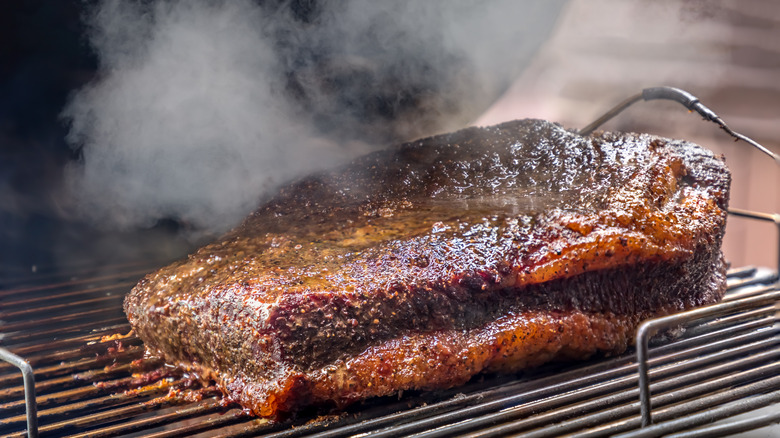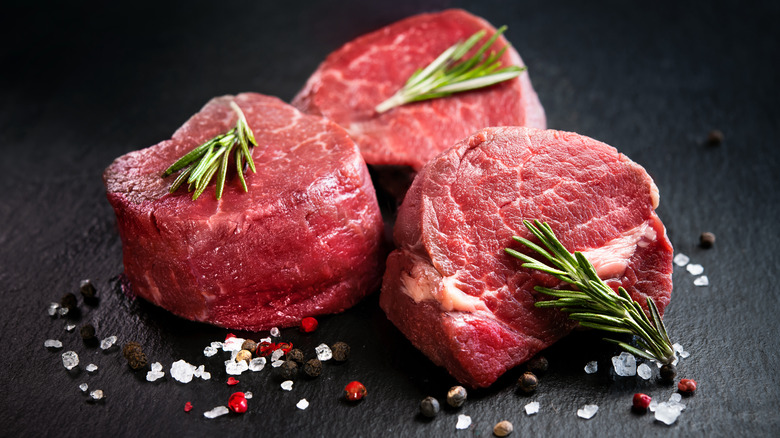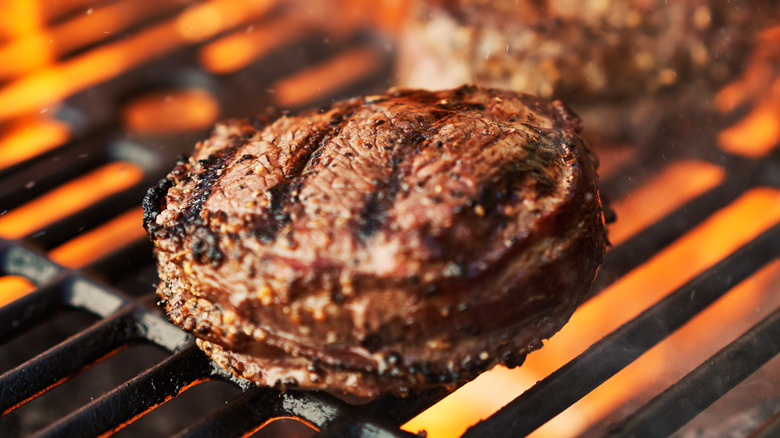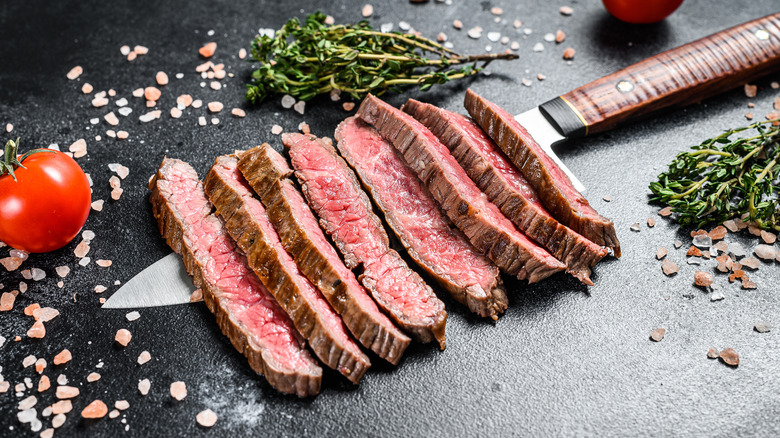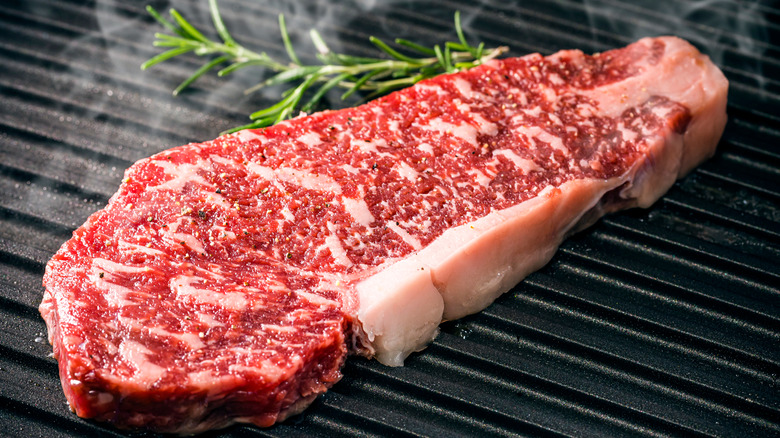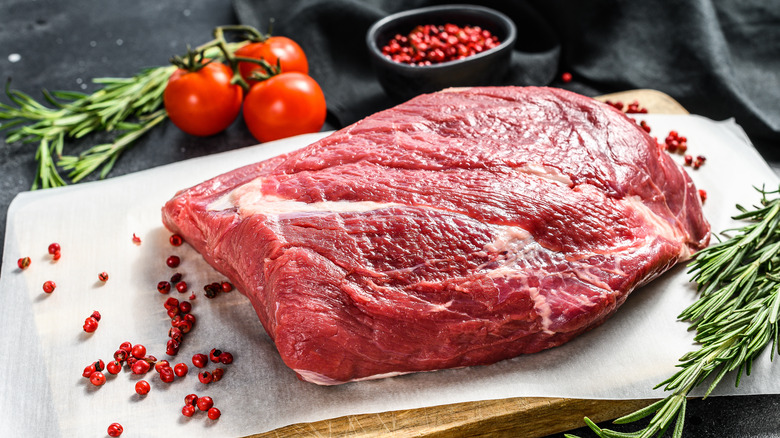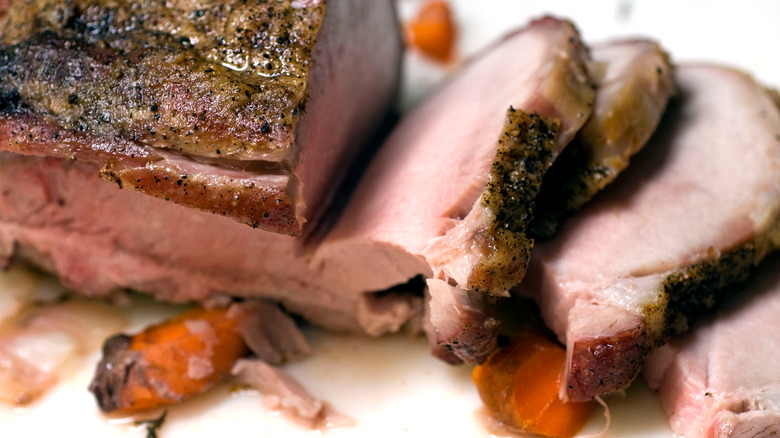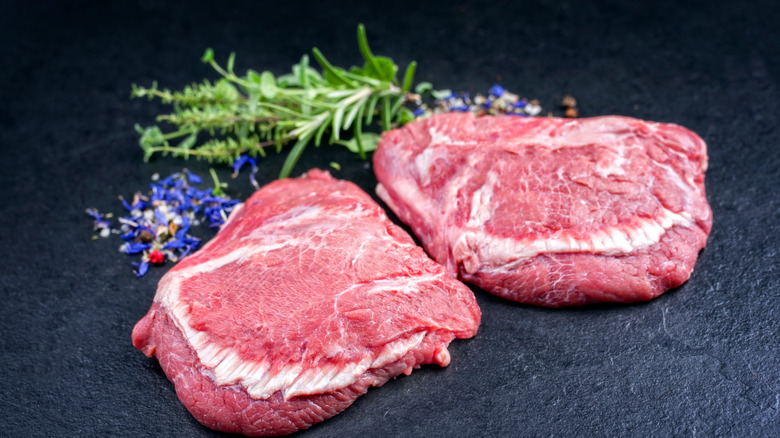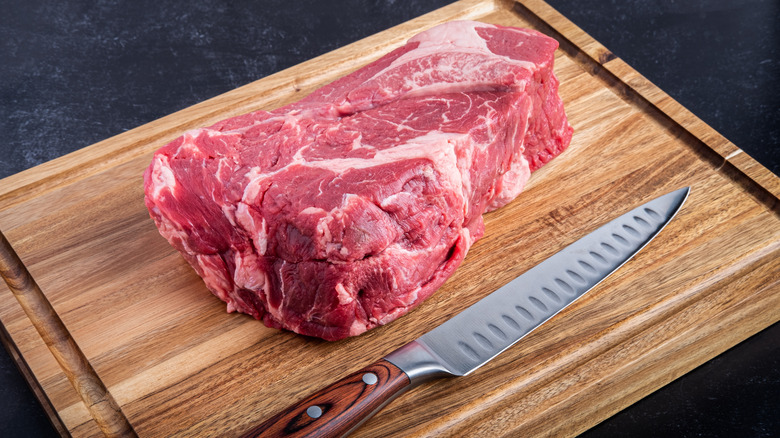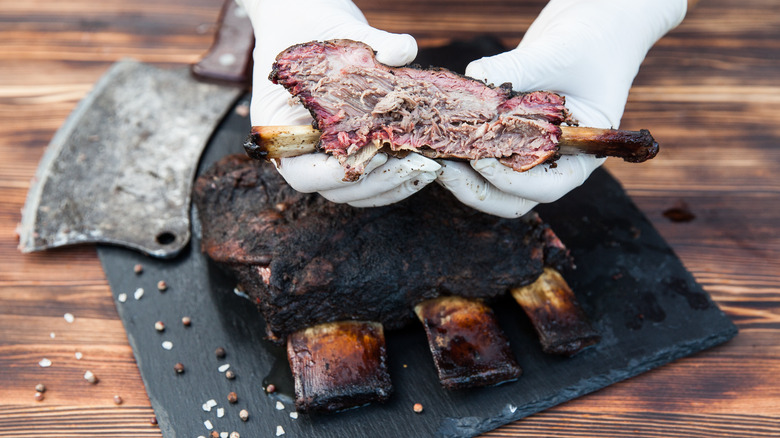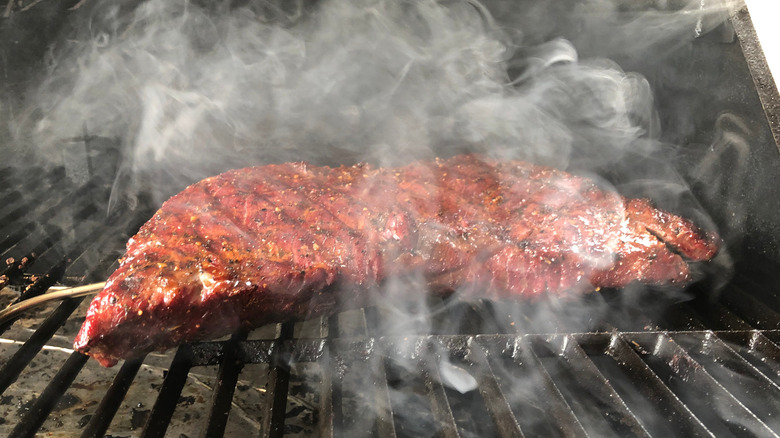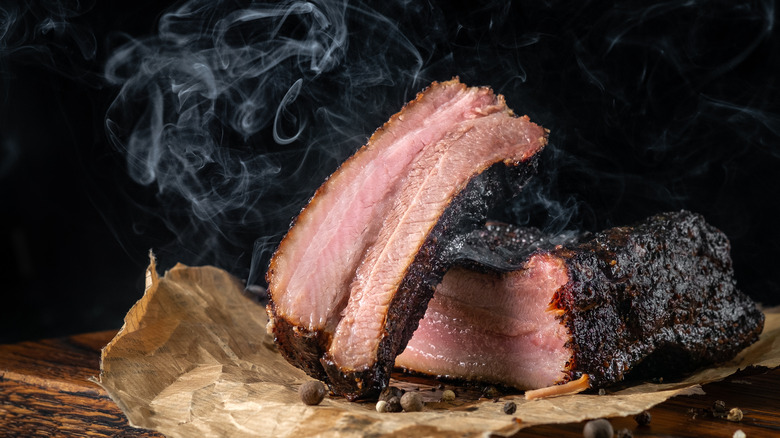Ranking 11 Cuts Of Steak To Smoke From Worst To Best
Smoking meat is a labor of love that requires time, patience, proper technique, and practice, but when done right, it can produce an unforgettable, mouth-watering experience. The tradition of smoking meats originated before preservatives as a means to prolong shelf life (via Daily Mail). Flash forward to the practice as we know it today, and it has evolved from a tool of necessity to culinary art.
The first key to smoking food is the proper smoker. While there are methods of smoking on a budget, the most efficient and consistent method is to use an actual gas, electric, charcoal, or wood-fired smoker. The next thing you'll need is plenty of time to utilize this "low and slow" technique, which can take anywhere from one hour to an entire day, depending on the cut and size.
Lastly, as any pitmaster will tell you, the most important piece of the smoker puzzle is to select the right cut of meat. While you can smoke just about anything from catfish to ice cream, the best protein for beginners and pitmasters alike who wish to hone their craft is smoked beef. But not all cuts of the cow are created equal, and it's not hard to mess up a good steak. In order to give you the best shot at smoking-hot success — and try to save your precious beef budget — we've wrangled up our list of steak cuts to smoke and ranked them from worst to best.
11. Filet mignon
Cut from the muscular end of the tenderloin, filet mignon is a classic and elegant steak that requires a lot of effort in a short amount of time — a bit counterintuitive as far as the art of smoking goes. Regarded as one of the most popular menu items at steakhouses in terms of cuts of steak, filet mignon comes from the loin, or the area below the backbone of the cow, which yields some of the most tender and buttery cuts of steak. The most important attribute as far as smoking is concerned, however, is that the filet mignon is one of the leanest cuts of steak, making it a perfect contender for a fast, high-temperature cooking method like grilled, seared, or broiled. If overcooked, filet mignon will quickly become dry and flavorless so it's best to save your smoker bucks on the cow's larger, higher-fat-content cuts.
10. Tenderloin
Much like the aforementioned filet, lean cuts of steak like the tenderloin don't contain as much collagen and therefore don't make good candidates for the labor of love that is smoking meat. Although collagen can be tough and chewy when in raw form, the key to using collagen to your advantage is by cooking beef with high collagen or fat contents low and slow, giving the collagen enough time to break down into gelatin so it yields a juicy and succulent texture. Tenderloin, on the other hand, does not contain a lot of collagen or fatty connective tissue, and will quickly dry out when overcooked, which can be the most disappointing outcome of any backyard barbecue. The ideal temperature for a medium-rare finish is 135 degrees Fahrenheit, making tenderloin an all too risky choice for the smoker's temperature range of 160 degrees Fahrenheit or more.
9. Flat iron
A rookie among other popular, well-known cuts of steak, the flat iron has made its mark as an innovative and flavorful cut. Carved from the chuck subprimal, or more specifically, the top muscle blade, the flat iron is a more modern cut of steak thanks to some clever butchering. In spite of an otherwise tough sinew running through the middle of the top blade, butchers found a way to slice either side of the sinew and divide the cut in half, thereby creating what we now know as a flat iron steak.
The pros at Omaha Steaks say that every cow produces two top blade roasts so the location yields a smaller portion of steak no matter how big the cow. As a more affordable option than similar cuts like tenderloin, the flat iron is commonly ranked the second most tender steak. Most steak lovers prefer the flat iron grilled, broiled, or pan seared to pack the boldest, beefy punch of flavor possible that doesn't come through as well with smoking.
8. Top sirloin
Top sirloin isn't really a star steak by any means, but it's also not a complete dud either as it's recommended for just about any cooking method, including smoking. This cut comes from the top portion of the sirloin butt, and tends to be on the leaner side, but that doesn't mean you can't smoke it to juicy perfection.
As one of the most versatile cuts on the market, top sirloin is also one of the most affordable, which is why Gourmet Sleuth recommends it as a great option for beginners. Since trial and error are part of learning how to smoke meat like a pro, top sirloin is a great way to learn from your mistakes without breaking the bank. Look for a higher-quality cut that hasn't been trimmed of all its fat, and also has a nice marbling throughout to give it a smoky and succulent finish. Best of all, if you overcook the sirloin and risk drying it out, you can always chop it up and salvage it in a recipe like beef stroganoff.
7. Top round
Top round — or any round cut of steak for that matter — comes from the rear leg and rump of the cow, and is typically far too tough a meat for most cooking methods, with the exception of the low and slow technique. This makes it a great option for the smoker. Another bonus to the top round is that it's an inexpensive cut that makes for an affordable option for feeding large groups or family barbecues without breaking the bank.
Preparation is key when cooking a top round, and anything but the perfect method will lead to what The Splendid Table would consider inedible. The trick is to braise the round before letting it slow cook in the smoker. Lastly, you'll want to slice it thinly and against the grain before serving so that it's less chewy. When prepared, cooked, and served properly, the top round can be a flavorful yet inexpensive option for the smoker.
6. Ribeye or prime rib
A crowd-pleaser by nature, there's really no wrong way to cook a ribeye, making it a low-risk and high-reward option that aims to please. It's also a great cut for beginners who can't afford to learn the art of smoking the hard way. The ribeye comes from the beef rib primal or upper rib section of the cow, meaning it's a lightly worked muscle with just the right amount of fat marbling and can be bone-in (produces more flavor) or boneless (harder to cook evenly as the meat closest to the bone cooks more slowly).
Although ribeye lovers tend to prefer a fast sear and pink center, the uncanny flavor of the ribeye holds up well in a low and slow smoker. That said, if ribeye fans can't sacrifice the grill for this cut, then give the prime rib a try in the smoker. Cut from the same cloth so to speak, the prime rib is larger and is typically butchered bone-in, producing a tender, juicy, and rich cut of beef.
5. Cheek
The best cuts for low and slow come from the harder-working parts of the cow. These cuts, like the beef cheek, are often overlooked by the at-home chef, but are loaded with flavor that's begging for the proper cooking method to match its tough nature. Beef cheeks come from the facial muscle of the cow, which is one of the hardest working muscles of the cow considering all they do is graze on grass for most of their lives.
All that grazing means there's plenty of connective tissue that will melt into a juicy, tender serving of beef when cooked low and slow in the smoker. Much like the flat iron, there are only two beef cheeks per cow, so the supply may be limited. The meat masters over at True Beef Organic recommend pre-ordering beef cheeks from your butcher, as you're unlikely to come across this rare cut already packaged in the grocery store.
4. Chuck roast
This large primal cut comes from the cow's shoulder, which makes it another tough and worthy opponent for the smoker. With marbling throughout, the chuck roast yields a generous portion of meat while requiring far less cooking time (five to six hours) as opposed to its other size-worthy opponents like brisket, which can take up to 20 hours depending on the size.
What is perhaps one of the most unique qualities of the chuck roast, is that the meat's connective tissue produces a basting effect as it melts, tenderizing the beef. It's basically the beef equivalent to a self-cleaning oven, which sounds like a win-win for both the smoker as well as the chef doing the smoking. Like most other large and tough cuts of beef, it's important to select a high-quality piece of chuck roast that is well-marbled throughout before you begin the smoking process.
3. Beef ribs
Collagen-rich cuts like beef ribs tenderize in a temperature-controlled smoker — which can range anywhere from 160 F to 250 F over the course of several hours. The end result is a melt in your mouth bite of beef ribs. There are three main types of beef ribs: chuck short ribs, plate short ribs, and back ribs, but when it comes to authentic Texas smoked barbecue, The Online Grill says there's only one that makes the cut, and that's the plate short rib.
Plate ribs typically consist of three ribs total, but they're fairly large slabs of meat as they come from the middle of the rib cage, meaning they can weigh a pound each, according to The Online Grill. The only downside is that beef ribs can be more difficult to find than say, pork. But much like other rare but worthy cuts of beef, it's best to request this cut from your butcher to guarantee quality and precision.
2. Tri-tip
Learning how to become a pitmaster is a long journey that takes time and practice, and the risk could cost you a pretty penny's slab of beef. Before taking the leap into more difficult cuts to smoke, pitmasters recommend starting with a cut that's naturally full of flavor and takes kindly to smoke. That's one of the many reasons why tri-tip is close to the top of the list.
It's the perfect crowd-pleaser at any backyard barbecue, and the best bet for beginners who are working on their smoking craft. Another reason the tri-tip is considered a more user-friendly option is that when cooked (whether smoked or grilled) to the ideal medium-rare, there will still be medium to well-done sections of the steak found closer to the ends, so no matter what doneness level your guests prefer, there will be a little slice of tri-tip heaven for everyone. The key to perfecting a tri-tip, no matter what the cooking method, is to give it ample time to marinate so the flavors soak in and help tenderize the meat.
1. Brisket
Brisket is the high-risk, high-reward cut that smokes like no other meat on the market. In a weight category all on its own, brisket was truly made for smoking. The sheer size of a properly butchered brisket demands the longest time in the smoker, making it a labor of love that requires serious skill. But when mastered, brisket truly defines the marriage between beef and smoke. But you can't spell Brisket without the "risk" so it's important to adhere to some rules set by the best in Texas-smoked barbecue.
For starters, celebrity chef and barbecue master Myron Mixon says that the most important factor for smoked brisket is to know your equipment inside and out, know its strengths and weaknesses, and what it's fully capable of. Another tip from Mixon is to inject the brisket by sticking a shot of flavor right to the center of the meat as opposed to a marinade, which only coats the outside of the thick cut.
Lastly, like most other cuts of beef, it's crucial not to skimp on the final details of brisket preparation, especially letting the meat rest before carving. The final step — carving the brisket — is a mastered skill all its own and takes a bit of maneuvering. The simple rule to remember with brisket, though, is to carve against the grain.
